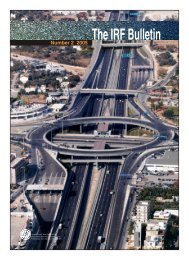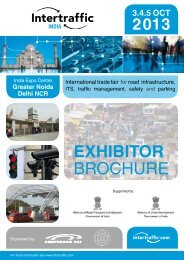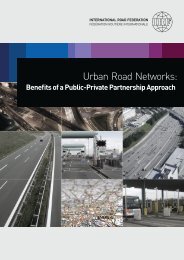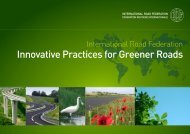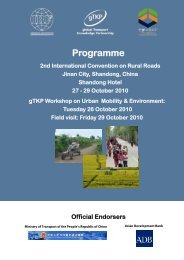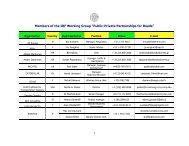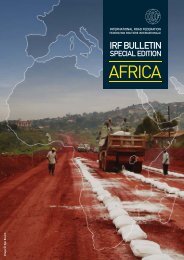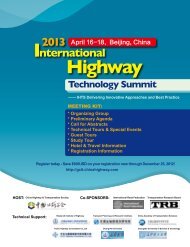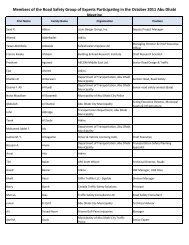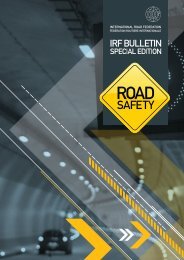TRANSPORT
TRANSPORT
TRANSPORT
- No tags were found...
You also want an ePaper? Increase the reach of your titles
YUMPU automatically turns print PDFs into web optimized ePapers that Google loves.
SOCIO-ECONOMIC BENEFITS<br />
Proportional Change of Travel by the Poor and Women<br />
60%<br />
50%<br />
40%<br />
30%<br />
44%<br />
53%<br />
20%<br />
10%<br />
0%<br />
-10%<br />
-20%<br />
12%<br />
Overall Poor Women Overall Poor Women<br />
Project<br />
Control<br />
-14%<br />
-30%<br />
-40%<br />
-32%<br />
-25%<br />
economic saving for the value of time). A greater variety of<br />
journeys and longer distances were recorded, with a higher<br />
proportion of journeys for the purpose of employment and<br />
business.<br />
Distributional Impacts<br />
More women travelled on the improved roads and the rate<br />
of increase in their number was higher than that of overall<br />
traveller numbers.<br />
Such a high proportional rise in travel by women is both<br />
noteworthy and welcomed. Women play an important<br />
part in the provision of transport in rural Kenya. They<br />
bear responsibility for a number of transport-related tasks,<br />
including collection of water, taking agricultural produce to<br />
markets, post-harvest transportation of crops from farms<br />
to home, and taking children and the elderly to health<br />
centres/hospitals. Their increased mobility is, therefore,<br />
likely to correlate strongly with increased socio-economic<br />
development of the citizens of Nyanza province.<br />
More poor people travelled on the improved roads. The<br />
poorer sections of the community have significantly<br />
increased their proportion of travel for employment and<br />
business purposes. This potentially reflects the increased<br />
economic opportunities now available.<br />
Perceived Impacts<br />
The opinion of the overwhelming majority of respondents<br />
was that road improvements had brought benefits to the<br />
people living within the road corridors. These benefits<br />
included lower costs of transport, greater availability of<br />
transport modes and easier use of bicycles. However,<br />
respondents also acknowledged that the improved<br />
roads had brought some disbenefits. The top three<br />
disbenefits identified were more accidents on the roads,<br />
environmental degradation and increased access to drugs<br />
for young people. One interesting disbenefit highlighted<br />
by some respondents was an increase in domestic violence<br />
associated with the improved roads. Such topics lend<br />
themselves to further study and investigation.<br />
Conclusion<br />
The Roads 2000 Nyanza Programme has shown that,<br />
despite political and environmental problems, success is<br />
achievable given sufficient determination and resolute will.<br />
The programme to develop the roads was administered<br />
and executed on time, and the resultant effects were<br />
broadly positive. Traffic volumes increased and costs were<br />
reduced for each mode of transport. Vehicle ownership<br />
grew and the benefits to women were proportionally<br />
greater than for other members of society. The citizens of<br />
the improved areas were positive about the programme.<br />
Motorcycle proliferation was a marked feature, which<br />
characterised the latter part of the decade and will need<br />
to be incorporated into future transport considerations.<br />
There was a move to more polluting (motorised) modes of<br />
transport. The link between socio-economic development<br />
and motorisation remains, however, essentially a problem<br />
of the 21st Century, and was not an issue investigated or<br />
targeted as an objective of the Roads 2000 Nyanza project.<br />
14<br />
| IRF BULLETIN SPECIAL EDITION: RURAL <strong>TRANSPORT</strong>, VOLUME-2



